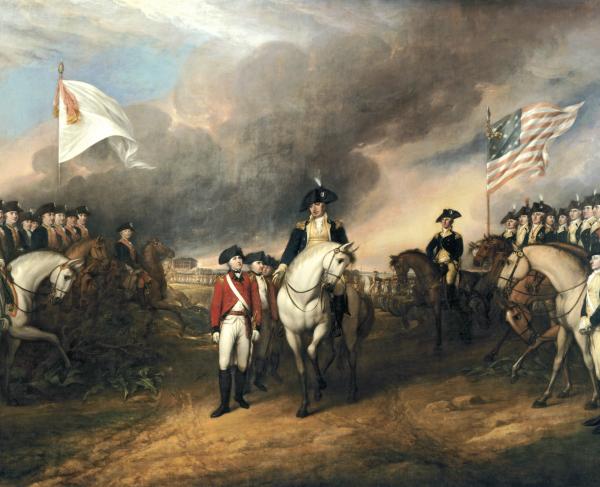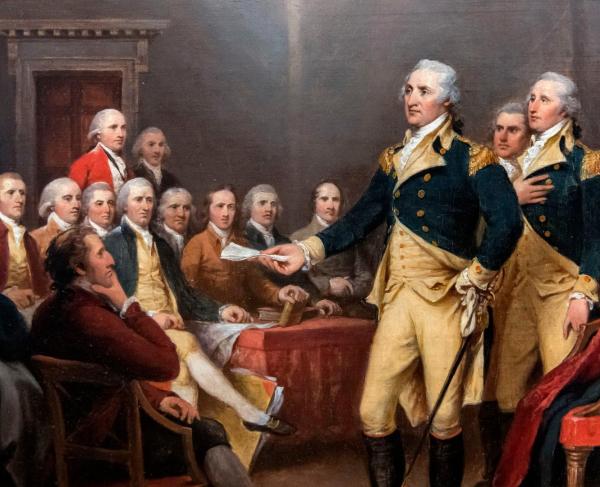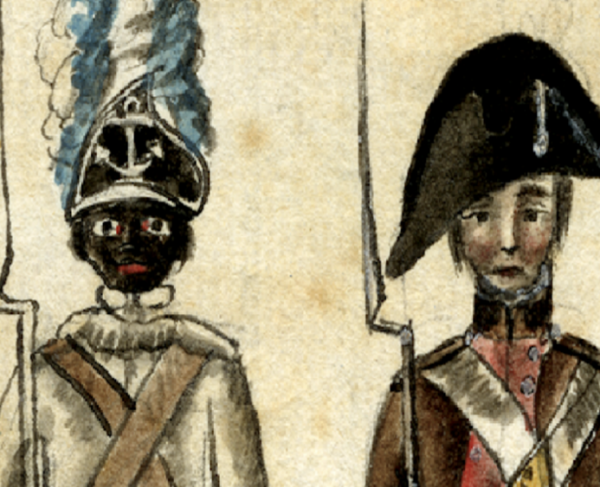Fix Bayonets: The Revolution’s Climactic Assault at Yorktown


On the evening of October 14, 1781, the sharp clanking of steel bayonets being fixed to muskets echoed through the dense fog that descended over the American earthworks outside of Yorktown, Va. The bayonet had been used extensively and effectively throughout the Revolutionary War, but this instance was extreme: Troops were forbidden to even load their muskets. Secrecy was paramount in this endeavor, and a single accidental musket shot could sink the whole operation. Success would mean that the Americans would be on top of the British soldiers before they could respond, a climactic assault in what had become a protracted siege.
The stakes were clearly high as General George Washington implored his men that they “act the part of firm and brave soldiers.” Captain Stephen Olney, commanding a company that would take part in the assault, later wrote that “his Excellency’s knees rather shook, but I have since doubted whether it was not mine.” Fear must have pervaded many of the men’s minds, as Olney remembered that many of the men were “no doubt, thinking, that less than one quarter of a mile would finish the journey of life with them.”
Earlier that summer, Washington had not planned on attacking the British in Yorktown at all. Instead, the Patriot commander focused on British General Henry Clinton’s army in New York City, until, in August, he was joined by a large French force under the command of the Comte de Rochambeau. After learning that a French fleet could come up from the West Indies and help in an attack against British General Charles Cornwallis’ army in Virginia, Washington made one of his most daring decisions of the war. He would feign an attack against New York City, and move his main force south. Encircled on land and sea, Cornwallis would have no choice but to surrender.
The British had prepared numerous earthen siege lines around the town and on the opposite side of the York River at Gloucester Point to defend themselves, at least until another naval force from New York could help them. These hopes were dashed on September 5 during the Battle of the Chesapeake, at which the French fleet scored a decisive victory and removed the possibility of evacuation by sea. When an allied force of French and American troops more than 17,000 strong arrived outside Yorktown on September 28, the British occupied these entrenchments, as well as a few outlying earthen redoubts. Two such small, polygonal forts prominent on the British left flank came to be known as Redoubts 9 and 10. They were well-prepared for an attack; any infantry assault on them would be a bloody affair.
Instead, the allied forces opened siege operations. As artillery from both sides bombarded each other for the next few weeks, the allies dug a siege trench, called a parallel (as it ran parallel to the British siege lines) 600 yards from the British defenses. Next, the French began to inch closer and build a second parallel just 300 yards from the British defenses. But in order to complete this parallel, Redoubts 9 and 10 needed to be taken — and quickly, before another British fleet could arrive to challenge French control of Chesapeake Bay and aid Cornwallis. After a two-day artillery assault on October 13–14, Washington believed the redoubts were weakened enough to be taken by an infantry assault.
The French, under the command of General Baron de Viomenil, would assault Redoubt 9 with 400 men, while the Americans, under the command of General Marquis de Lafayette, would assault Redoubt 10 with another 400 men. Lafayette gave his former aide-de-camp, French Lieutenant Colonel Jean-Joseph Sourbader de Gimat, the honor of leading the American troops against Redoubt 10. However, young Lieutenant Colonel Alexander Hamilton protested that he should have the honor of leading the Americans, as he had seniority over Gimat. When Lafayette would not change his mind, Hamilton appealed directly to Washington, who agreed and gave him the honor of leading the American light infantry.
Early on the evening of October 14, small diversionary attacks were made against the British right flank and at Gloucester Point to confuse the British. Strategy for the main assault was simple: axe-wielding pioneers (also known as sappers or miners) would work to break up the abatis and fraises, making holes for the bayonet-wielding infantry to pour through. Abatis were obstacles made by placing tangled and sharpened branches in front of a fort to repel any assaulting infantry in much the same way barbed wire would do in later wars. The fraises were large, sharpened wooden poles anchored into the sides of the fort. Both obstacles could cause deadly delays for the attackers.

At 7:00 p.m., six signal guns fired into the air and the assaults commenced. Swiftly, 800 French and American troops climbed out of the first parallel and ran across the cratered no man’s land toward the earthen fortifications. As the American light infantry arrived at Redoubt 10 and the pioneers began their work, the 70 British defenders discovered the movement and quickly ran to the parapet and began firing into the dark figures. Captain Olney remembered “the enemy fired a full body of musketry. At this, our men broke silence and huzzaed.” Impatient for the pioneers to finish their work, they charged quickly through the few holes in the abatis that had been cut away or destroyed by artillery. They dropped into the ditch and began working their way up through the fraises onto the parapet of the redoubt. “Rush on, boys!” the officers cried as the men charged up the sides. Sergeant Joseph Plumb Martin remembered that as he rushed toward the redoubt “a man at my side received a ball in his head and fell under my feet, crying out bitterly.” The men clawed their way up the side of the redoubt or stood on the shoulders of others to climb upward. British soldiers began throwing hand grenades into the ditch, causing havoc. The bright flashes of musket discharges and explosions illuminated the dark night.
Captain Olney made it to the top of the parapet and yelled, “Olney’s company form on me!” He was immediately met with numerous British bayonets. Using his spontoon (a large spear officers carried), he was able to fight off a few, but received two bayonet wounds, in his leg and stomach. In a seeming miracle, just as Olney prepared to be overwhelmed by the enemy, two American soldiers who had fortuitously loaded their muskets while in the ditch popped up and fired into the British, who quickly ran away or surrendered.
A desperate struggle ensued on the parapet of Redoubt 10, as American and British soldiers locked in a deadly hand-to-hand brawl with musket butts, bayonets, pistol shots and musket fire. Despite the mounting casualties, the American troops were unrelenting. The officers led by example: Hamilton was conspicuously gallant in the assault, and Gimat was wounded by a musket ball in his foot as he led his men forward. As the American troops flowed over the walls of the redoubt, many of the British troops began to retreat toward their main lines. Lieutenant Colonel John Laurens of South Carolina led a detachment of 80 men around to the rear of the redoubt to cut off British defenders trying to retreat. In less than 10 minutes, the remaining British troops threw down their muskets and surrendered to the Americans. Hamilton noted that “incapable of imitating examples of barbarity, and forgetting recent provocations” all the defenders were given quarter. The Americans had lost nine men killed and 25 men wounded; the British had eight men killed and 20 taken prisoner, including the redoubt’s commander, Major James Campbell.
As the last shots were fired inside Redoubt 10, Lafayette joyously sent a message to Viomenil reporting his victory and asking, “Where are you?” Viomenil’s men had begun their assault at the same time as the American troops, with loaded muskets and fixed bayonets. However, when the French troops arrived at the abatis outside Redoubt 9, they discovered that almost none of it had been destroyed in the bombardment. The French pioneers began to break up the obstacles, and the soldiers stopped in their tracks and waited, forbidden to fire until they were inside the fort. A sentry from the redoubt called out for the shadowy figures to identify themselves, and when there came no answer, the 120 British and Hessian troops inside fired into the French soldiers.
The French pioneers stubbornly removed the abatis while they and their fellow soldiers endured a hailstorm of lead. Unlike the Americans, the disciplined French soldiers stood patiently as musket balls zipped through their lines. One French soldier remembered the fire being so galling that it seemed “it was raining bullets” and “we fell just like snowflakes.” After a few minutes, a hole was cleared, and the French soldiers surged forward.
Once they made it to the top of the parapet, they opened fire into the garrison’s defenders. The British and Hessian defenders attempted a bayonet charge, but the resilient French forced them back. A scene of confusion and horror engulfed the small fort as saber and bayonet thrusts were exchanged by the two desperate sides. After a few minutes of this havoc, the British and Hessian soldiers threw down their arms and surrendered or escaped back to their main lines. The entire affair took about 30 minutes, and was far bloodier than the fighting at Redoubt 10. The French lost 15 men killed and 77 wounded; the British and Hessians lost 18 men killed and 50 captured.

With the works firmly under American and French control, the allies were able to finish the second parallel and bring artillery to within 300 yards of the British main defenses. Washington was elated with the conduct of his men, reporting two days later to the Continental Congress that “Nothing could exceed the firmness and bravery of the troops. They advanced under the fire of the enemy without returning a shot, and effected the business with the bayonet only.”
Cornwallis, realizing that escape was impossible and further resistance pointless, requested a ceasefire on October 17 and, on October 19, more than 8,000 British and Hessian soldiers surrendered to the allied forces. The humiliating disgrace for the Crown forces became Washington’s largest victory. Although the war continued for another two years, Yorktown marked the last major land combat of the Revolution and drained all support of the war in London. When the British prime minister heard of the defeat, he exclaimed, “Oh, God! It is all over!”
Today, the National Park Service owns and preserves this hallowed ground in perpetuity. While the original earthworks of Redoubts 9 and 10 no longer exist, re-creations constructed in the 20th century, largely by the Civilian Conservation Corps during the Depression mark their locations. Once the sight of brutal hand-to-hand combat, these war-torn fields now provide a place for quiet reflection on one of the most dramatic moments in our nation’s founding.


